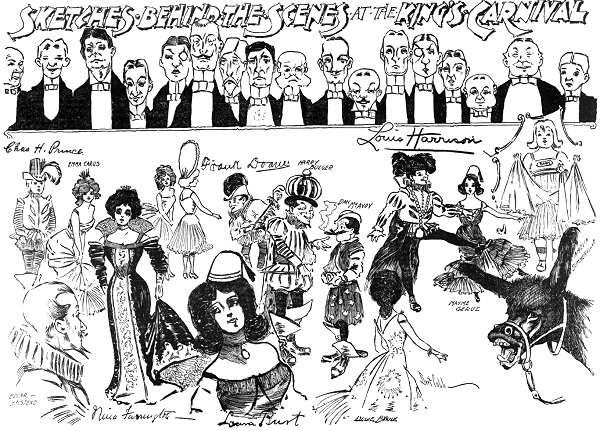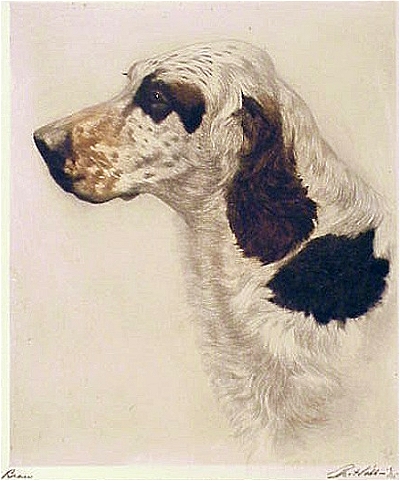
 Albert Andrews "Bert" Cobb (March, 1869 to April 2, 1936) | |
 Selected Covers (Hover to View) Selected Covers (Hover to View) | |
Bert Cobb managed to leave a mark on American cartoon and sheet music cover art, as well as fine portraits of canines, while not leaving much of one on public records, making it difficult to obtain very much information on his life. He was born in Chicago, Illinois in 1869 to Ohio native Henry Zenal Cobb and his Illinois wife Sarah Johnson. The family was in the bed-spring business at that time. However, they soon moved to Wilmington, Delaware where Henry expanded into making car springs for carriages and trains. Albert had at least seven siblings, including Henry Zenal (1867), Henry Reid (1871), A. Pullman (1874), Kate (1877), and a brother born in 1880 who died in infancy.

 By 1900 only Albert, A. Pullman, Henry Z. and Kate were still alive. Henry Z. Cobb became an inventor, and usually lived near his younger brother.
By 1900 only Albert, A. Pullman, Henry Z. and Kate were still alive. Henry Z. Cobb became an inventor, and usually lived near his younger brother.


After being educated in Wilmington at a military school, Bert went to the Philadelphia Academy of Fine Arts in the late 1880s. There he learned etching and cartooning, as well as working with woodcuts and half-tone lithography. It was in cartooning that he got his start, working first at the Kansas City Star, then in Philadelphia around 1898. While there he contributed comic strips to the syndicated McClure's Sunday Section and did occasional work for the Philadelphia Sunday Press By 1900 Bert was residing in New York City and contributing humorous writings and comic caricatures to various papers through syndication, focusing largely on the New York Morning Telegraph Sunday edition. The left-handed artist also illustrated a few small books that might be considered the pulp fiction of their time.
Bert branched out and took on a bit of sheet music cover art jobs during this period. Most of his work covers 1900 to 1903, supporting publishers E.T. Paull and Howley, Haviland & Dresser. He is now largely known for his early "coon song" caricature covers for H, H & D, but Bert tackled some fine art projects as well. This includes the simple but elegant Arizona, Champagne, Broken Ties and Where the Orange Blossoms Bloom for Paull. Even though they were largely monochromatic, an unusual move for the publisher who was known for using brilliant multi-color chromolithographic covers, Bert's drawings showed amazing detail and depth. His covers were rarely seen after 1903, but a couple appear as late as 1911 under the Jerome H. Remick logo.
 |
On February 26, 1901, Bert was married to Louise Ann McMurray in Manhattan. The following year Cobb launched a comic art and literature-based periodical called Pen and Ink which included contributions from other cartoonists, along with fellow illustrators Frank Butler and Reo Bennett. It also included contributions from Palmer Cox who was known for his Brownies characters. It did not last very long, folding within a year. The 1905 New York State census showed Bert and Louise living on 5th Avenue in Manhattan, with Bert working as an artist.
Over the next several years, Cobb's cartooning work was seen in the political humor magazine Puck, as well as in the New York Globe. He had a brief court battle with the American Newspaper Syndicate in Washington, DC in 1905, winning a suit for an account due of $75 for his work. Around 1906 Cobb moved to Boston and his strips were found in the Boston Herald and the Boston Post. A 1907 syndicated strip was about a clumsy fellow named Stumble-Toe Joe. One that appeared in the Herald from 1907 to 1908 was Ambitious Teddy about a boy who was at times a bit zealous. Another good humorous example of mischievous children was a strip that ran in 1911 called Meddlesome Millie about a little girl that constantly got into trouble.
During the mid-1910s Cobb became the official cartoonist for the Republican National Committee, responsible for all of the cartoons issued in conjunction with the presidential campaign of William Howard Taft. During World War I (the "Great War"), he drew a number of Liberty Loan posters in support of bonds to fund the effort. Before 1916 he had moved back to New York City where he became a member of the New York Press Club and the New York Illustrator's Club. There he did some artwork for an early rendition of Life Magazine (not the same one that started in the 1930s). Among his more interesting enterprises that did not quite launch was the intent to make animated cartoons in Rochester, New York, as noted in a 1917 article in the Rochester Democrat.
Mr. Cobb had not been here three days, he said yesterday afternoon when he realized that he might help in putting the city on the motion picture map, and incidentally, himself on the financial map. … Animated cartoons—pen and ink drawings that are as lifelike as, and funnier than, genuine motiong pictures—will be produced by the artist in a way that never before has been attempted. Already Mr. Cobb has been obliged to hire assistants because of the amount of work he is doing. He has two cartoonists in view now, and later, with larger quarters, he will have an office and studio staff of about fifteen persons.
His reasons for picking Rochester were due to it being the home of photographic film manufacturer Eastman Kodak. The methodology he planned to use was a stop-motion technique with cutouts. At least one catoon of a dog, Chubby's Capers, was exhibited in Rochester in March, 1917. None of these cartoons are known to exist,
so are likely lost films. Certainly three years before Walt Disney started his enterprise in Kansas City, something could have come of this. But he was soon back in New York City.
 |
Around 1922 Bert married again, this time to German immigrant Elizabeth "Lisa" Balsie. The couple lived in the Bronx in upper New York City, but did not have children. That same year, he created a notable series of cartoons honoring "Captains of the Automobile Industry," which appeared in newspapers through the United States and Canada. Cobb changed directions in his drawing career in the early 1920s, and starting in 1923 he devoted himself mostly to dry point etchings of famous dogs. Many of them were commissioned by the owners of award winning canines, and his reputation grew to the point where he was almost constantly in demand. This further resulted in multiple coast to coast gallery exhibits from the mid-1920s to the early 1930s. The most prestigious of these showings were held at the Kraushaar Galleries in New York. Cobb also compiled at least two books of his artwork published in the early 1930s, Portraits of Dogs and Hunting Dogs, in addition to doing fine illustrations for many others. He was also the unofficial cartoonist for the Republican National Committee.
In the 1930 census Bert and Elizabeth were still living in the Bronx, with Bert listed as an artist. They moved to a Cleveland Drive address in Harmon, New York, within a couple of years. In mid-March 1936 Cobb was admitted to Grasslands Hospital in nearby Valhalla with pneumonia, dying on the morning of April 2 after a ten day illness at age 66. His ashes were interred at the Cobb family vault in Wilmington, Delaware, on April 5. From that point forward, Lisa was the keeper of his memory, a veritable curator of many of his sketches. Bert's original art works, particularly his dogs, still command prices as high as the four digit range nearly a century later.